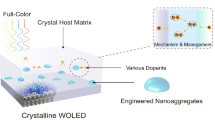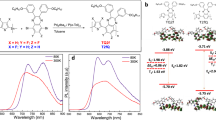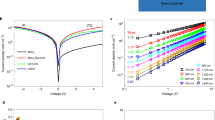Abstract
Crystalline organic semiconductors are potentially attractive media for advanced organic solid-state light-emitting devices due to their advantageous highly oriented transition dipole moments and high mobility of charge carriers, which should in principle lead to efficient light emission; however, crystalline organic semiconductor-based organic light-emitting diodes (C-OLEDs) have until now struggled with poor device performance. Here we report a method to create high-performance C-OLEDs by using organic solid-solution thin films of deep-blue fluorescent materials. Our C-OLED exhibits a strong photon output capacity and has an external quantum efficiency of up to 6.5% with Commission Internationale de L’Eclairage (CIE) colour coordinates of around (0.15, 0.07). The driving voltage (4.0 V@1,000 cd m–2), power efficiency (3.9 lm W–1@1,000 cd m–2) and series-resistance joule-heat loss ratio (11.1%@1,000 cd m–2) outperform deep-blue amorphous OLEDs (CIEy ≤ 0.08), making it an attractive approach for next-generation OLED technologies.
This is a preview of subscription content, access via your institution
Access options
Access Nature and 54 other Nature Portfolio journals
Get Nature+, our best-value online-access subscription
$29.99 / 30 days
cancel any time
Subscribe to this journal
Receive 12 print issues and online access
$209.00 per year
only $17.42 per issue
Buy this article
- Purchase on Springer Link
- Instant access to full article PDF
Prices may be subject to local taxes which are calculated during checkout




Similar content being viewed by others
Data availability
All of the data are available in the main text or Supplementary Information. Source Data are provided with this paper.
References
Pope, M., Magnante, P. & Kallmann, H. P. Electroluminescence in organic crystals. J. Chem. Phys. 38, 2042–2043 (1963).
O’Neill, M. & Kelly, S. M. Ordered materials for organic electronics and photonics. Adv. Mater. 23, 566–584 (2011).
Wang, C. L., Dong, H. L., Jiang, L. & Hu, W. P. Organic semiconductor crystals. Chem. Soc. Rev. 47, 422–500 (2018).
Gierschner, J. et al. Luminescence in crystalline organic materials: from molecules to molecular solids. Adv. Opt. Mater. 9, 2002251 (2021).
Ding, R., An, M. H., Feng, J. & Sun, H. B. Organic single-crystalline semiconductors for light-emitting applications: recent advances and developments. Laser Photon. Rev. 13, 1900009 (2019).
Liu, C. F., Liu, X., Lai, W. Y. & Huang, W. Organic light-emitting field-effect transistors: device geometries and fabrication techniques. Adv. Mater. 30, 1802466 (2018).
Qin, Z. S., Gao, H. K., Dong, H. L. & Hu, W. P. Organic light-emitting transistors entering a new development stage. Adv. Mater. 33, 2007149 (2021).
Wan, Y. et al. Efficient organic light-emitting transistors based on high-quality ambipolar single crystals. ACS Appl. Mater. Interfaces 12, 43976–43983 (2020).
Kuehne, A. J. C. & Gather, M. C. Organic lasers: recent developments on materials, device geometries, and fabrication techniques. Chem. Rev. 116, 12823–12864 (2016).
Jiang, Y. et al. Organic solid-state lasers: a materials view and future development. Chem. Soc. Rev. 49, 5885–5944 (2020).
Liang, J., Yan, Y. & Zhao, Y. S. Organic microlaser arrays: from materials engineering to optoelectronic applications. Acc. Mater. Res. 2, 340–351 (2021).
Zhang, X. T., Dong, H. L. & Hu, W. P. Organic semiconductor single crystals for electronics and photonics. Adv. Mater. 30, 1801048 (2018).
Shi, Y. L., Zhuo, M. P., Wang, X. D. & Liao, L. S. Two-dimensional organic semiconductor crystals for photonics applications. ACS Appl. Nano Mater. 3, 1080–1097 (2020).
Kim, K. H. & Kim, J. J. Origin and control of orientation of phosphorescent and TADF dyes for high-efficiency OLEDs. Adv. Mater. 30, 1705600 (2018).
Watanabe, Y., Sasabe, H. & Kido, J. Review of molecular engineering for horizontal molecular orientation in organic light-emitting devices. Bull. Chem. Soc. Jpn. 92, 716–728 (2019).
Coropceanu, V. et al. Charge transport in organic semiconductors. Chem. Rev. 107, 926–952 (2007).
Pope, M. & Swenberg, C. E. Electronic Processes in Organic Crystals (Oxford Univ. Press, 1982).
Cai, X. Y. & Su, S. J. Marching toward highly efficient, pure-blue, and stable thermally activated delayed fluorescent organic light-emitting diodes. Adv. Funct. Mater. 28, 1802558 (2018).
Schmidt, T. D. et al. Emitter orientation as a key parameter in organic light-emitting diodes. Phys. Rev. Appl. 8, 037001 (2017).
Nakanotani, H. & Adachi, C. Organic light-emitting diodes containing multilayers of organic single crystals. Appl. Phys. Lett. 96, 053301 (2010).
Ding, R. et al. Fabrication and characterization of organic single crystal-based light-emitting devices with improved contact between the metallic electrodes and crystal. Adv. Funct. Mater. 24, 7085–7092 (2014).
Liu, J. et al. High mobility emissive organic semiconductor. Nat. Commun. 6, 10032 (2015).
Yang, X. X. et al. Highly efficient crystalline organic light-emitting diodes. J. Mater. Chem. C 6, 8879–8884 (2018).
An, M. H. et al. Well-balanced ambipolar organic single crystals toward highly efficient light-emitting devices. Adv. Funct. Mater. 30, 2002422 (2020).
Liu, L. et al. Highly oriented crystalline thin film with high electroluminescence performance fabricated by weak epitaxy growth. Org. Electron. 84, 105806 (2020).
Xin, J. H., Sun, P. F., Zhu, F., Wang, Y. & Yan, D. H. Doped crystalline thin-film deep-blue organic light-emitting diodes. J. Mater. Chem. C 9, 2236–2242 (2021).
Tang, C. W., Vanslyke, S. A. & Chen, C. H. Electroluminescence of doped organic thin-films. J. Appl. Phys. 65, 3610–3616 (1989).
Kido, J., Kimura, M. & Nagai, K. Multilayer white light-emitting organic electroluminescent device. Science 267, 1332–1334 (1995).
Lee, M. T., Liao, C. H., Tsai, C. H. & Chen, C. H. Highly efficient, deep-blue doped organic light-emitting devices. Adv. Mater. 17, 2493–2497 (2005).
Reineke, S., Thomschke, M., Lussem, B. & Leo, K. White organic light-emitting diodes: status and perspective. Rev. Mod. Phys. 85, 1245–1293 (2013).
Hong, G. et al. A brief history of OLEDs-emitter development and industry milestones. Adv. Mater. 33, 2005630 (2021).
Kitaigorodsky, A. I. Mixed crystals (Springer, 1984).
Takeuchi, M., Ueno, S. & Sato, K. Synchrotron radiation SAXS/WAXS study of polymorph-dependent phase behavior of binary mixtures of saturated monoacid triacylglycerols. Cryst. Growth Des. 3, 369–374 (2003).
Shao, Y. & Yang, Y. Organic solid solutions: Formation and applications in organic light-emitting diodes. Adv. Funct. Mater. 15, 1781–1786 (2005).
Zhen, Y. G. et al. Organic solid solution composed of two structurally similar porphyrins for organic solar cells. J. Am. Chem. Soc. 137, 2247–2252 (2015).
Schwarze, M. et al. Band structure engineering in organic semiconductors. Science 352, 1446–1449 (2016).
Thomas, S. P. et al. Bandgap tuning in molecular alloy crystals formed by weak chalcogen interactions. J. Phys. Chem. Lett. 12, 3059–3065 (2021).
Lusi, M. A rough guide to molecular solid solutions: design, synthesis and characterization of mixed crystals. CrystEngComm 20, 7042–7052 (2018).
Wang, H. B., Zhu, F., Yang, J. L., Geng, Y. H. & Yan, D. H. Weak epitaxy growth affording high-mobility thin films of disk-like organic semiconductors. Adv. Mater. 19, 2168–2171 (2007).
Yang, J. L. & Yan, D. H. Weak epitaxy growth of organic semiconductor thin films. Chem. Soc. Rev. 38, 2634–2645 (2009).
Xin, J. H. et al. High-efficiency non-doped deep-blue fluorescent organic light-emitting diodes based on carbazole/phenanthroimidazole derivatives. J. Mater. Chem. C 8, 10185–10190 (2020).
Liu, D., Zhu, F. & Yan, D. Crystalline organic thin films for crystalline OLEDs (I): orientation of phenanthroimidazole derivatives. J. Mater. Chem. C 10, 2663–2670 (2022).
Kuo, C. J. et al. Bis(phenanthroimidazolyl)biphenyl derivatives as saturated blue emitters for electroluminescent devices. J. Mater. Chem. 19, 1865–1871 (2009).
Wang, Z. et al. Phenanthro[9,10-d]imidazole as a new building block for blue light emitting materials. J. Mater. Chem. 21, 5451–5456 (2011).
Hong, K. & Lee, J. L. Recent developments in light extraction technologies of organic light emitting diodes. Electron. Mater. Lett. 7, 77–91 (2011).
Frischeisen, J., Yokoyama, D., Adachi, C. & Bruetting, W. Determination of molecular dipole orientation in doped fluorescent organic thin films by photoluminescence measurements. Appl. Phys. Lett. 96, 073302 (2010).
Xiang, Y. P. et al. Acceptor plane expansion enhances horizontal orientation of thermally activated delayed fluorescence emitters. Sci. Adv. 6, eaba7855 (2020).
Komino, T., Tanaka, H. & Adachi, C. Selectively controlled orientational order in linear-shaped thermally activated delayed fluorescent dopants. Chem. Mater. 26, 3665–3671 (2014).
Ding, R. et al. Clarification of the molecular doping mechanism in organic single-crystalline semiconductors and their application in color-tunable light-emitting devices. Adv. Mater. 30, 1801078 (2018).
Kang, J. et al. Time-resolved electroluminescence study for the effect of charge traps on the luminescence properties of organic light-emitting diodes. Phys. Status Solidi A 217, 2000081 (2020).
Huh, D. H., Kim, G. W., Kim, G. H., Kulshreshtha, C. & Kwon, J. H. High hole mobility hole transport material for organic light-emitting devices. Synth. Met. 180, 79–84 (2013).
Uratani, H. et al. Detailed analysis of charge transport in amorphous organic thin layer by multiscale simulation without any adjustable parameters. Sci. Rep. 6, 39128 (2016).
Hu, J. Y. et al. Bisanthracene-based donor-acceptor-type light-emitting dopants: highly efficient deep-blue emission in organic light-emitting devices. Adv. Funct. Mater. 24, 2064–2071 (2014).
Pal, A. K. et al. High-efficiency deep-blue-emitting organic light-emitting diodes based on iridium(III) carbene complexes. Adv. Mater. 30, 1804231 (2018).
Ahn, D. H. et al. Highly efficient blue thermally activated delayed fluorescence emitters based on symmetrical and rigid oxygen-bridged boron acceptors. Nat. Photon. 13, 540–546 (2019).
Kim, K. et al. Efficiency enhancement of InGaN/GaN blue light-emitting diodes with top surface deposition of AlN/Al2O3. Nano Energy 43, 259–269 (2018).
Swayamprabha, S. S. et al. Approaches for long lifetime organic light emitting diodes. Adv. Sci. 8, 2002254 (2021).
Scholz, S., Kondakov, D., Lussem, B. & Leo, K. Degradation mechanisms and reactions in organic light-emitting devices. Chem. Rev. 115, 8449–8503 (2015).
Ho, Y. H., Lin, T. C., Wu, C. F. & Lee, J. H. High efficiency and long lifetime fluorescent blue organic emitting device. Proc. SPIE 6333, 633303 (2006).
Hotta, S., Kimura, H., Lee, S. A. & Tamaki, T. Synthesis of thiophene/phenylene co-oligomers. II [1]. Block and alternating co-oligomers. J. Heterocycl. Chem. 37, 281–286 (2000).
Acknowledgements
This work was funded by the National Key R&D Program of China (grant no. 2017YFA0204704 to D.H.Y). We acknowledge Jilin Yuanhe Electronic Material Company for support in preparing materials, Y. Wang for support in calculating TDM, D. Ma and D. Yang for support in measuring angle-dependent photoluminescence.
Author information
Authors and Affiliations
Contributions
F.Z. and D.H.Y. initiated and designed the research. P.F.S. performed the growth of the crystalline thin films, the fabrication and characterization of the OLEDs. D.L. contributed to the crystal structure characterization of 2FPPICz and OSS crystalline thin films. F.Z. and D.H.Y. supervised the project. All authors discussed the results, prepared and commented on the manuscript.
Corresponding author
Ethics declarations
Competing interests
The authors declare no competing interests.
Peer review
Peer review information
Nature Photonics thanks Wenping Hu and the other, anonymous, reviewer(s) for their contribution to the peer review of this work.
Additional information
Publisher’s note Springer Nature remains neutral with regard to jurisdictional claims in published maps and institutional affiliations.
Supplementary information
Supplementary Information
Supplementary Figs. 1–17, Notes 1 and 2, and Tables 1–5.
Source data
Source Data Fig. 1
Original data of Fig. 1.
Source Data Fig. 2
Original data of Fig. 2.
Source Data Fig. 3
Original data of Fig. 3.
Source Data Fig. 4
Original data of Fig. 4.
Rights and permissions
Springer Nature or its licensor (e.g. a society or other partner) holds exclusive rights to this article under a publishing agreement with the author(s) or other rightsholder(s); author self-archiving of the accepted manuscript version of this article is solely governed by the terms of such publishing agreement and applicable law.
About this article
Cite this article
Sun, P., Liu, D., Zhu, F. et al. An efficient solid-solution crystalline organic light-emitting diode with deep-blue emission. Nat. Photon. 17, 264–272 (2023). https://doi.org/10.1038/s41566-022-01138-0
Received:
Accepted:
Published:
Issue Date:
DOI: https://doi.org/10.1038/s41566-022-01138-0
This article is cited by
-
High-efficiency crystalline white organic light-emitting diodes
Light: Science & Applications (2024)
-
Research on interfacial change and regulation of organic light-emitting diodes under thermal stress
Journal of Materials Science (2024)
-
Electron conduction properties of emitting layer containing nanoaggregates in crystalline OLEDs
Journal of Materials Science: Materials in Electronics (2023)



